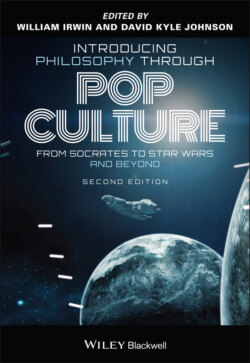Читать книгу Introducing Philosophy Through Pop Culture - Группа авторов - Страница 26
The Good, the Bad, and … Well, That's it Really
ОглавлениеOur goal is not just to form arguments. We need to form good arguments, and we need to evaluate the arguments of others. There are good arguments and there are bad arguments in both the deductive and inductive realms. A good argument, in either realm, is one in which the conclusion logically follows from the premises and all of the premises are true. If either one of these conditions is absent, then the argument is bad and should be rejected.
In the deductive realm, that a conclusion follows from premises means that the argument is valid (or invalid if the conclusion does not follow). When an argument is valid and all the premises are true, the argument is said to be a good, sound argument. The conclusion absolutely, positively, without a doubt, is true, and this is a good thing! In the inductive realm, that a conclusion likely will follow from premises means that the argument is strong (or weak if the conclusion likely does not follow). When an argument is strong and all the premises are true, the argument is said to be a good, cogent argument. The conclusion is most likely or probably true, and this is a good thing too!
So, as rational, adult critical thinkers we must always go through this two‐step procedure of checking our own arguments and the arguments of others to see if (A) the conclusion follows from the premises (is the argument deductively valid or inductively strong?) and (B) all of the premises are true. If the argument fails to meet either (A) or (B) or both, then we should reject it, thereby rejecting the person's conclusion as either absolutely false or probably false. For example, Cartman's argument for pooling together the boys' teeth is probably a bad one because Premise 2 seems false, given the information. It is not true that if they get money from the Tooth Fairy then they will be able to buy a Sega Dreamcast, because the Tooth Fairy only gave Cartman $2.00. The sum of $2.00 × 4 boys is $8.00 and, provided we are talking about a new one from the store, that is not enough to buy a Sega Dreamcast. So in the case of this particular deductive argument, the conclusion “If the boys combine their teeth, then they can get a Sega Dreamcast” is false. On the other hand, the Towelie argument was a good one. It was true that the few times they mentioned towel‐related things, Towelie showed up. And given this fact, they had a strong case for drawing the conclusion that he would show up again asking, of course, “Wanna get high?”
